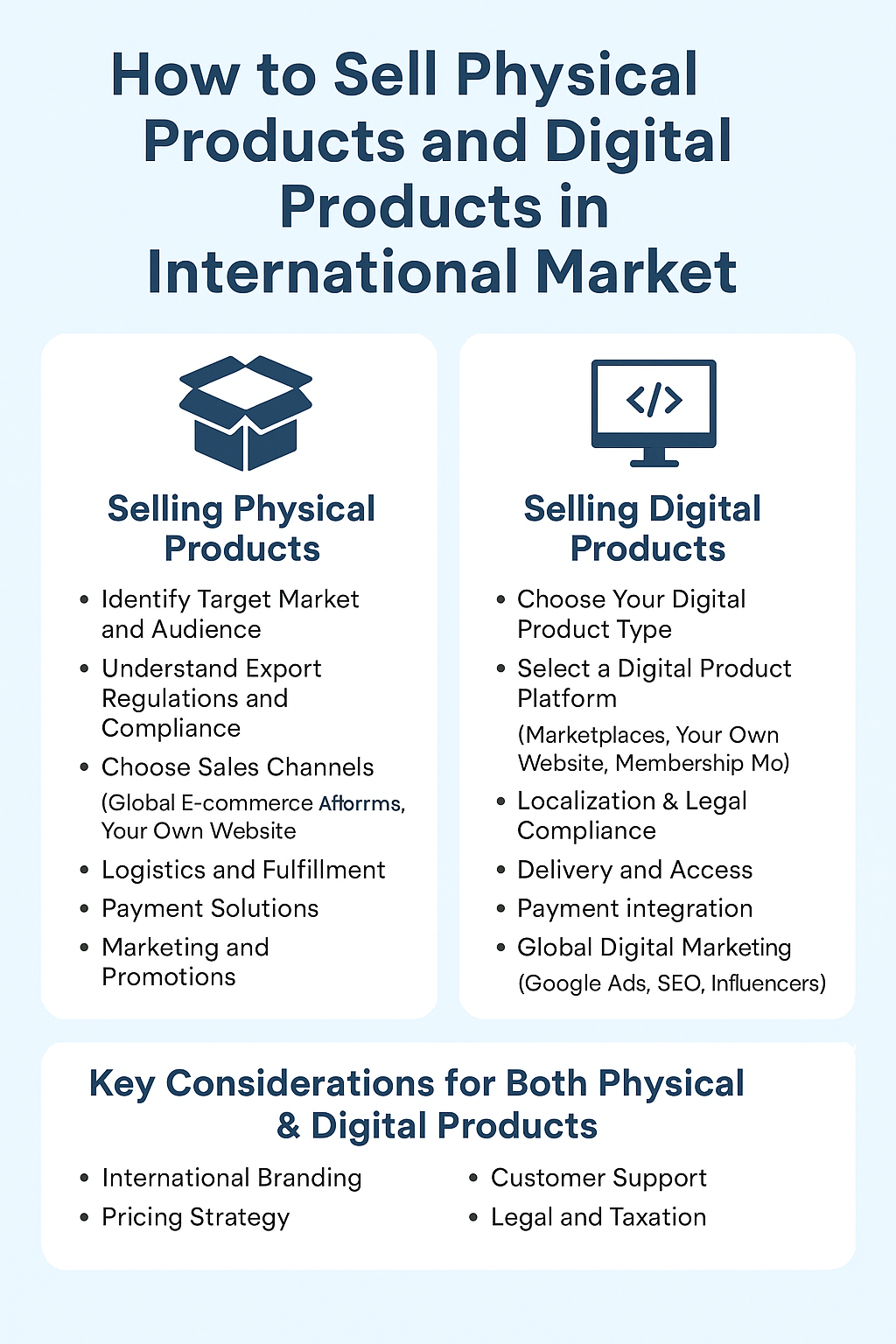Physical Products and Digital Products
In today’s interconnected world, businesses have unprecedented opportunities to sell both physical and digital products to customers across the globe. However, entering international markets requires a well-planned strategy, an understanding of export-import regulations, and the right digital tools to manage global sales effectively.
This article will guide you step-by-step on how to sell physical products (like machinery, clothing, electronics) and digital products (such as software, e-books, online courses) in the international market.
Selling Physical Products in International Market
1. Identify Target Market and Audience
- Research which countries have a demand for your product.
- Analyze buyer behavior, preferences, and purchasing power.
- Use tools like Google Market Finder, Trade Map, or local market reports.
2. Understand Export Regulations and Compliance
- Register with export regulatory bodies (like DGFT in India, U.S. Department of Commerce, etc.).
- Check product-specific export-import restrictions, certifications (CE Mark, FDA approval, etc.), and labeling requirements.
- Understand Incoterms (FOB, CIF, DDP) to negotiate shipping terms with buyers.
3. Choose Sales Channels
- Global E-commerce Platforms: Amazon Global, eBay, Alibaba, Etsy.
- Your Own Website with International Shipping: Set up a Shopify or WooCommerce store with cross-border shipping options.
- Distributors and Agents: Appoint local distributors or commission-based agents for market penetration.
4. Logistics and Fulfillment
- Partner with reliable freight forwarders and courier services (DHL, FedEx, Aramex).
- Decide on fulfillment models: Direct shipping, local warehousing, or third-party logistics (3PL).
- Ensure proper packaging to meet international shipping standards.
5. Payment Solutions
- Offer multiple international payment methods: PayPal, Stripe, credit cards, wire transfers.
- Consider currency conversion and exchange rate fluctuations.
6. Marketing and Promotions
- Use digital marketing (SEO, Google Ads, Social Media Ads) targeted to specific countries.
- List products on B2B trade portals and attend international trade fairs (virtually or physically).
- Localize your content — translate your website and product descriptions into local languages.
Selling Digital Products in International Market
1. Choose Your Digital Product Type
- Software, Mobile Apps
- E-books, Whitepapers
- Online Courses & Webinars
- Graphics, Templates, Stock Photos
- Music, Videos, Podcasts
2. Select a Digital Product Platform
- Marketplaces: Udemy (courses), Amazon Kindle (eBooks), Envato (design templates), App Store/Google Play (apps).
- Your Own Website: Sell through Shopify Digital Downloads, Gumroad, or Kajabi.
- Membership Models: Create subscription-based services for premium content.
3. Localization & Legal Compliance
- Adapt your digital content for cultural relevance.
- Ensure compliance with international digital tax regulations (like EU VAT for digital products).
- Protect intellectual property through copyrights and licensing agreements.
4. Delivery and Access
- Use secure digital delivery systems to provide instant access upon payment.
- Implement Digital Rights Management (DRM) to prevent unauthorized distribution.
- Automate license keys for software and app downloads.
5. Payment Integration
- Use global payment gateways with digital product compatibility (Stripe, PayPal, Paddle).
- Offer multiple currencies and ensure compliance with international tax invoicing.
6. Global Digital Marketing
- Run region-specific Google Ads, Facebook Ads, and LinkedIn campaigns.
- Use SEO strategies to rank in target country searches.
- Collaborate with local influencers and affiliate marketers.
- Provide multilingual customer support.
Key Considerations for Both Physical & Digital Products
- International Branding: Maintain a consistent global brand image but be flexible to local preferences.
- Customer Support: Provide multilingual support through email, chatbots, or call centers.
- Pricing Strategy: Adjust pricing based on market demand, competition, and currency fluctuations.
- Legal and Taxation: Ensure compliance with international tax treaties, digital service taxes, and customs duties.
Conclusion
Selling physical and digital products internationally opens up new revenue streams and global brand visibility. However, success lies in detailed market research, legal compliance, choosing the right platforms, and implementing strategic marketing. With the right approach and a focus on customer experience, businesses can thrive in international markets, whether selling tangible goods or digital solutions.

